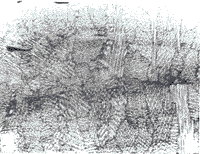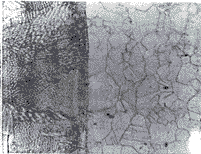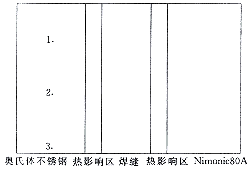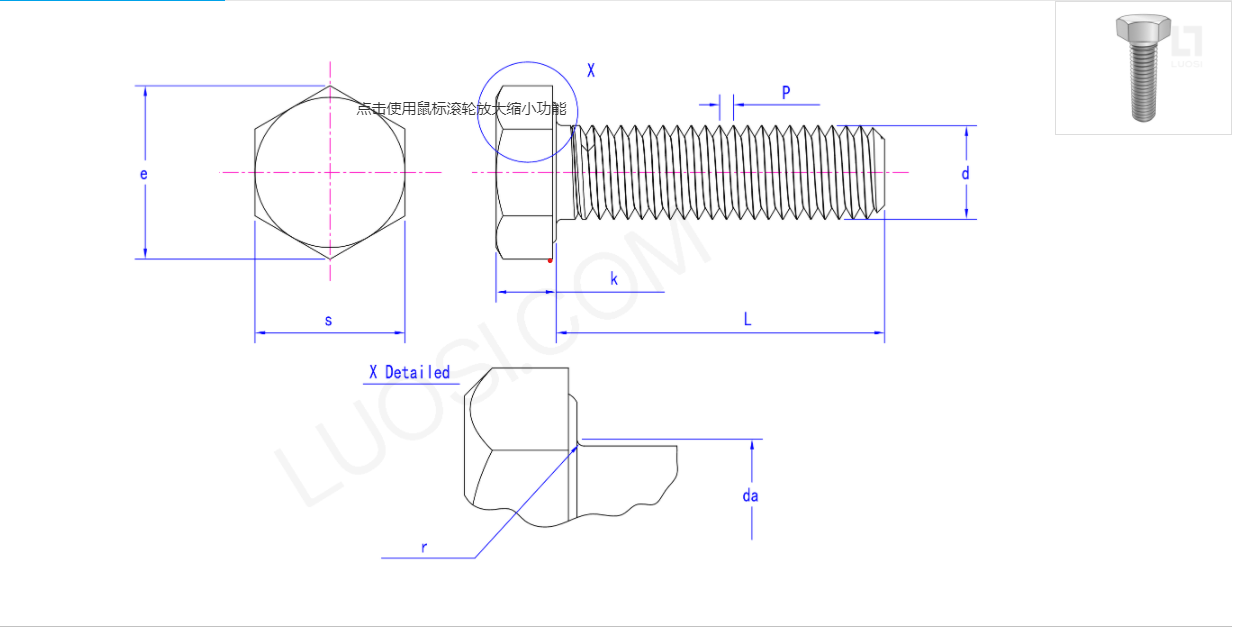Abstract : Compared with Nimonic80A super alloy exhaust valve, austenitic stainless steel and Nimonic80A bimetal exhaust valve not only have the same excellent thermal strength and hot corrosion resistance, but also low cost. The electron beam welding method of bimetallic exhaust valve was studied. The microstructure, mechanical properties and weldability of weld and heat affected zone were analyzed and discussed. Key words: exhaust valve; electron beam welding; weldability Figure 1 Schematic diagram of electron beam welding of bimetallic exhaust valve Table 1 Chemical Dimensions of Bimetal Exhaust Valves (Wt.%) X-ray inspection is performed on the three bimetallic exhaust valves that have been welded, one is taken in the direction of the vertical weld, the microstructure of the weld and the heat-affected zone is observed and analyzed, and the hardness and high-temperature tensile properties are tested. The other two are performed. Installed actual ship assessment experiment. Figure 2 Weld of the bimetallic exhaust valve (2) Microstructure The sample was polished in cross section. After etching with copper sulfate solution, the microstructure of the weld and heat affected zone (shown in Figure 3) was observed under MM6 metallographic microscope. The weld was fine dendritic crystal, columnar The grain grows along the direction perpendicular to the parent metal, that is, the fastest heat dissipation, but does not penetrate the weld. The width of the heat affected zone is less than 1 mm, and no metallurgical defects such as cracks or pores are observed. Figure 3 400 times the microstructure of the weld and heat affected zone (3) The Vickers hardness of the welded base metal, weld zone and heat affected zone was measured by Vickers hardness, and the test load was 10 kg. The results are shown in Figure 4 and Table 2. It is worth pointing out that in order to investigate the effects of thermal cycling in the welding process, the hardness of different locations in each zone is measured. Figure 4 Schematic diagram of hardness measurement position Table 2 Vickers hardness of the weld zone of bimetallic exhaust valve Table 3 Calculated values ​​of weld composition The composition has a chromium-nickel ratio of 0.5, which is much larger than the Suutala crack sensitivity coefficient ratio of 1.48 [2]. From the hardness value of the weld, it is known that there is little or no strengthening phase precipitation during solidification and crystallization, which is beneficial for preventing hot cracks in the weld. References [1] Service Experience of The MC Engines[R]. MAN B&W Diesel A / S.
HEX BOLT: One type of fastener, consisting of the head and the rod (cylinder with external full/half threads) and usually uesd together with nut.washer.
According to clients' demands, material can be Stainless Steel SS304/316/316L, Duplex Steel S32750/32760/2205/NAS660/904L..
The Standard is various, main standard is DIN/ANSI/GB, of course we also can accept JIS/BSW
Raw material should be cut in concrete length and processed by Cold/hot forge.surface finish,then can become various size fasteners.
Our Stainless Steel fasteners have great quality and are widely used in Heavy Industry.Shipping Industry.Construction Industry.Chemical Industry and Marine Industry.
Hex Bolt is one of our advantage Products. Chinese Manufacture, Qualified Hardware and Fasteners, Different size/Diameter/Tooth pitch, we all can satiafy your demands.
Hex Bolt,Hex Head Bolt,Hex Bolt Fastener,Stainless Steel Hex Bolt Taizhou Risco Stainless Steel Products Co.,Ltd , https://www.riscofastener.com
Classification : TG113.263 Document code: A
The exhaust valve is one of the most demanding parts for medium and low speed marine diesel engines. It not only operates at temperatures of up to 600-800 ° C, but also withstands high thermal loads, and is also operated under mechanical loads such as vibration and shock. The resulting thermal fatigue, mechanical fatigue, wear, ablation and hot corrosion have become the main damage methods. The above problems are further aggravated by the quality of the fuel. As we all know, the world oil price rose twice in 1973 and 1986, forcing ship owners to use inferior crude oil, further reducing the life of the exhaust valve. Increasing the heat intensity and hot corrosion resistance of the exhaust valve has become the key to ensure the normal maintenance cycle of medium and low speed marine diesel engines.
As a countermeasure, on the one hand, the design of the exhaust valve is continuously improved from the structure, on the other hand, superalloys such as Nimonic80A and Nimonic81 are used as new exhaust valve materials, and their service life has reached more than 10,000 h. The downside is that the expensive cost of such exhaust valves has made it difficult for many ship owners to accept. For this reason, people have developed a bimetallic exhaust valve, that is, the parts with serious damage to the valve body are superalloyed, and the rest are still traditional. Valve material. MAN has successfully produced this bimetallic exhaust valve by hot isostatic pressing [1]. This is undoubtedly the direction of producing high quality and low price exhaust valves. 2. This paper introduces another electron beam welding method for bimetallic exhaust valves.
1 Experimental method
Electron beam welding has been successfully used for superalloy welding because of its high energy density and precise control of welding line energy. The bimetallic exhaust valve welded by electron beam is welded with a Nimonic 80A superalloy ring on the seat of a common austenitic stainless steel exhaust valve (as shown in Figure 1). The superalloy ring has an inner and outer diameter of 300 mm and 390 mm and a thickness of 20 mm. Nimonic80A is subjected to standard 1080 ° C / 8 h / air cooling solution treatment and 700 ° C / 16 h / air cooling aging treatment. The welding process focuses the electron beam to the junction of the valve seat and the ring, while melting the austenitic stainless steel and Nimonic 80A to form a molten pool without using any wire filler. Welding process parameters such as accelerating voltage, beam current, welding speed, focusing current, etc. are selected to ensure that the weld has the largest aspect ratio and the smallest heat affected zone without cracks and the electron beam just penetrates the workpiece. Metallurgical defects such as pores. The chemical composition of the exhaust valve used for welding and the Nimonic 80A superalloy ring is shown in Table 1. 
Body material Nimonic80A C 0.29 0.07 Mn 1.66 0.04 S 0.014 <0.001 P 0.023 <0.005 Si 1.36 0.16 Cr 20.82 19.51 Ni 8.31 76 Mo 0.38 - W 2.50 - Co 0.27 - Fe 64.3 - Al - 1.40 Ti - 2.59
2 Experimental results
(1) The microstructure of the weld and the heat affected zone are shown in Figure 2. The weld width to width ratio is ~10, no obvious heat affected zone, no visible metallurgical defects. 



1 2 3 A 249 242 247 B 292 274 264 C 215 219 219 D 227 287 299 E 357 354 351
(5) The actual life of the two exhaust valves has exceeded 10,000 h, and the average ablation rate of the valve seat is less than 0.3 mm/1000 h.
(1) Changes in the microstructure of the weld and heat affected zone The solidification and crystallization process of the weld pool metal and the thermal cycling of the adjacent base metal under its action directly affect the microstructure of the weld and the heat affected zone, apparently with welding The method and the process parameters of the welding process are closely related. If the composition of the weld pool is the average of the austenitic stainless steel and Nimonic80A components, as shown in Table 3. C Mn S P Si Cr Ni Mo W Co Fe Al Ti 0.18 1.35 0.007 0.012 0.76 20.1 42.1 0.19 1.25 0.15 32.2 0.7 1.3
In addition, in the heat affected zone of austenitic stainless steel, the hardness value decreases along the weld from top to bottom. Nimonic80A is in an increasing trend, which is undoubtedly due to the fact that the heat input in the upper part of the weld is greater than the lower part during the welding process, resulting in a temperature gradient in the heat affected zone. Because at different temperatures, the precipitation of carbides and the dissolution kinetics of the γ' phase are different. The temperature in the heat-affected zone near the upper part of the weld is higher than that in the lower part, and more carbides are precipitated in the austenitic stainless steel, which increases the hardness. In contrast, the γ' strengthening phase precipitated after the aging treatment of Nimonic80A dissolves at high temperatures, which reduces the hardness. Obviously, keeping the hardness difference in a certain critical range is necessary to ensure the performance of the exhaust valve. The high temperature tensile specimens were broken in the base material region of austenitic stainless steel, which proved that the microstructure of the weld and heat affected zone had higher thermal strength.
(2) Solderability of Nimonic 80A superalloy It is generally believed that the superalloy strengthened by aluminum-titanium has strong crack sensitivity during welding, so there is strong solidification crack in the weld and heat affected zone during solidification crystallization. The tendency of liquefaction crack and strain aging crack formation, different welding methods and process parameters have different crack sensitivities. In addition, the crack sensitivity is also related to the total amount of elements formed in the γ' phase. It has been pointed out that when the total amount exceeds 6%, the thermal crack is sensitive [3]. Nimonic80A superalloy has a total aluminum and titanium content of about 4%, and the crack sensitivity coefficient is 10% to 15%, which is still weldable. In addition to Al, Ti, S, Si, C, B and other elements have a great influence on the welding performance. These elements are almost all enriched in the grain boundary, and it is easy to form a liquid film along the grain boundary to cause cracks during the solidification process. Arata et al. define a brittle temperature range (BTR) for this purpose [4]. It is worth noting that although the Al and Ti contents of the weld metal are lower than those of Nimonic 80A, the S and P contents are much higher, and the crack sensitivity is also increased due to the deflection under high-speed cooling conditions. Therefore, it is very important to choose the appropriate welding method and welding process parameters and strictly control the impurity content of the welding base metal. In this experiment, there are no visible cracks in the weld and heat affected zone, indicating that the electron beam welding method and the adopted process parameters are feasible for the welding of austenitic stainless steel and Nimonic80A superalloy.
4 Conclusion
(1) The bimetallic exhaust valve consisting of austenitic stainless steel and Nimonic80A can be completed by electron beam welding, and the operating life has exceeded 10,000 h. (2) The weld is composed of fine dendritic columnar crystals with a heat-affected zone width of ~1 mm. There are no visible metallurgical defects such as cracks and pores. (3) The thermal strength of the weld and heat affected zone is higher than that of the austenitic stainless steel base metal.
About the author : Guan Delin (1946~), male, professor
Author : Guan Delin College of Marine Engineering, Dalian Maritime University, Dalian 116026, China;
Institute of Metal Materials Technology, Dalian University of Maritime, Dalian 116026, China
[2] Lippold J C. Solidification Behavior and Cracking Susceptibility of Pulsed -Laser Welds in Austenitic Stainless Steels [J]. Welding Journal June, 1994, 73(6): 129.
[3] Chinese Society of Mechanical Engineering, Welding Society, Welding Manual [M]. Beijing: Mechanical Industry Press, 1992.
[4] Arata Y , Matsuda F and Katayama S. Trans Solidification Crack Susceptibility in Weld Metals of Fully Austenitic Stainless Steels [J]. Trans JWEI, 1977, 6(1): 105. 
Electron beam welding of bimetallic exhaust valves
(4) High temperature stretching High temperature stretching temperature is 415 °C. The diameter of the three samples is 8 mm with a gauge length of 40 mm. The average values ​​of σs, σb and δ are 240 N/mm2, 500 N/mm2 and 17.5%, respectively. The samples broke in the austenitic stainless steel region away from the weld.
3 Discussion